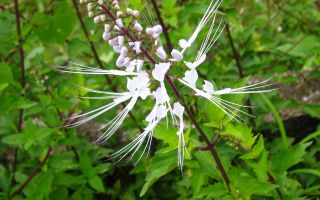Content
- 1 What it looks like and where it grows
- 2 Kidney tea herb composition
- 3 What kidney tea helps with
- 4 Can i drink kidney tea during pregnancy and hepatitis B?
- 5 Kidney tea - diuretic or not
- 6 How to take kidney tea
- 6.1 How much to drink kidney tea
- 6.2 When is it better to drink kidney tea
- 6.3 How to drink kidney tea during pregnancy for edema
- 6.4 Kidney tea for cystitis
- 6.5 Kidney teas for sand, kidney stones
- 6.6 Kidney tea for gout
- 6.7 Kidney tea for kidney cysts
- 6.8 Orthosiphon staminate with increased intracranial pressure
- 6.9 How to drink kidney tea bags
- 7 Kidney tea for weight loss
- 8 Contraindications
- 9 Side effects of kidney tea
- 10 Collection and procurement
- 11 Conclusion
- 12 Reviews of the medicinal properties of staminate or renal tea orthosiphon
The medicinal properties of staminate orthosiphon and contraindications are of particular interest to supporters of traditional medicine. The plant is widely used in the treatment of urological diseases. It belongs to the group of natural diuretics. Orthosiphon is of particular value for overweight people.
What it looks like and where it grows
Orthosiphon staminate is an evergreen plant belonging to the Yasnotkovy family. More than 190 of its varieties are represented in nature. The height of the stem can reach 1.5 m. The oblong leaves are oval in shape and serrated at the edges. The plant is distinguished by racemose inflorescences and filamentous stamens. Because of them, the people began to call the orthosiphon "cat's whisker". The flowers of the plant are pale purple in color, and the fruits resemble small nuts.
Orthosiphon staminate is widespread in Southeast Asia, Australia and India. On the territory of the Russian Federation, the plant is found on the Black Sea coast, in the Crimea and the Caucasus. It prefers fertile, loose soil and a humid climate. The flowering process of orthosiphon takes place in July.
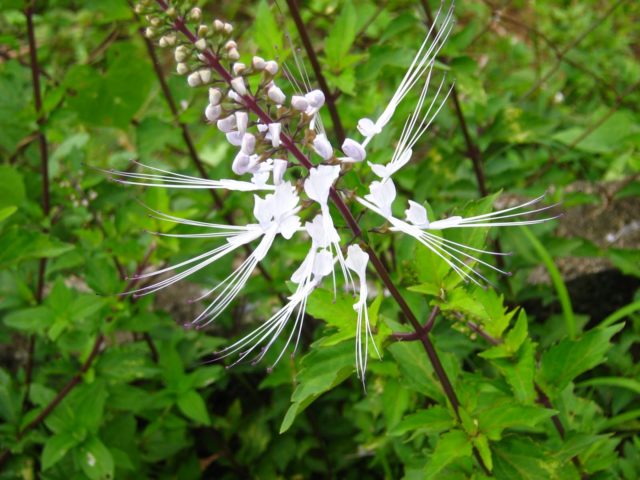
Kidney tea herb composition
The beneficial effect of the plant on the urinary system and the entire body as a whole is due to the rich content of nutrients. It contains components that have a pronounced diuretic effect and anti-inflammatory effect. For medicinal purposes, the ortisophone is grown on special plantations. It contains the following components:
- saponins;
- tannins;
- orthosiphonin glycoside;
- rosmarinic acid;
- essential oils;
- β-sitosterol;
- organic acids;
- minerals (zinc, copper, ferum, cobalt, magnesium and manganese);
- phenol carboxylic acids;
- potassium salts;
- meso-inositis;
- vitamins;
- flavonoids.
The diuretic effect of staminate orthosiphon is achieved due to the content of saponins. When ingested, they break down into separate compounds that provide enzyme production. Organic acids in the plant are responsible for the anti-inflammatory effect and the removal of toxic substances from the body. Flavonoids dilate blood vessels and help relieve swelling.
The glycosides present in renal tea improve appetite and stimulate the digestive system. Tannins help inhibit the growth of malignant tumors and cope with the inflammatory process. The vitamin component has a beneficial effect on the immune system, increasing the body's resistance to bacteria. Potassium salts normalize cardiac activity and take part in the regulation of water-salt balance. Rosmarinic acid, in turn, enhances the antimicrobial and antioxidant activity of other components.
What kidney tea helps with
Kidney tea is used for chronic and acute diseases of the urinary system. It relieves pain attacks and normalizes the outflow of fluid from the body. If the problem is caused by an inflammatory process, the constituent components of orthosiphon improve glomerular filtration and lower the acidity of urine. This helps to deal with the problem that has arisen. Among other things, kidney tea has a choleretic effect, which is extremely useful for diseases of the pancreas. Indications for the use of staminate orthosiphon in humans:
- cardiovascular diseases;
- diabetes;
- excessive swelling;
- gout;
- hypertension;
- atherosclerosis;
- urethritis and cystitis;
- stone formations in the gallbladder.
Kidney tea is considered a fairly powerful diuretic, so it is undesirable to use it for preventive purposes. It can act as the main remedy and complement drug therapy. Ortosiphon increases the secretion of gastric juice, increasing the amount of saline in it. That is why kidney tea can be used to treat diseases of the gastrointestinal tract.
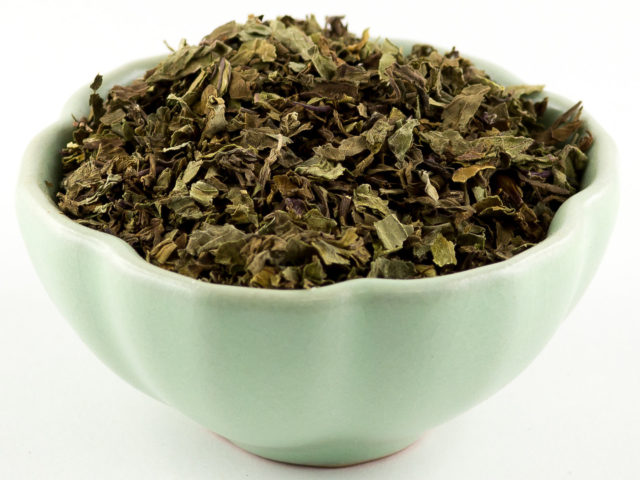
In some cases, kidney tea is used for general strengthening of the body, especially during the period of increased flu and colds. It contains substances with a pronounced immunomodulatory effect. Herbal medicine with renal tea helps to cope with cardiovascular pathologies. This is due to the removal of the load from the heart and the normalization of the blood pressure level.
Useful properties of orthosiphon for men
Useful properties and contraindications of orthosiphon are of interest to both women and men. Males use the plant to treat prostate adenoma and inflammation in the genital area. It helps to improve fertility. In addition, kidney tea effectively reduces the risk of stroke and has a cleansing effect on the blood. For older men, orthosiphon is beneficial for its ability to regulate blood pressure.
What is useful for women
Among the indications for the use of staminate orthosiphon in women, gynecological diseases, impaired lactation and overweight are distinguished. Substances in its composition stop inflammation in the small pelvis and eliminate pain. Weight loss is aided by a diuretic action. When using renal tea, toxins and toxins are eliminated from the body. It promotes overall health and helps in weight loss.
Some women drink kidney tea during PMS. It has a mild sedative effect and relieves spasms of smooth muscles. Sometimes kidney tea is used to rinse the hair. This helps make them more shiny and obedient. Its addition to caring face masks makes the skin firmer and smoother.
What is useful for children and at what age
Kidney tea should only be given to children over the age of 12. But before that, it is advisable to consult a pediatrician, as the plant can provoke allergies. The dosage of the remedy should be adjusted according to the weight of the child.
Can i drink kidney tea during pregnancy and hepatitis B?
For pregnant women, kidney tea is an excellent alternative to medications. Due to its natural origin, it does not have a systemic effect on the body, but it helps to cope with the problem that has arisen. In the 1st trimester of pregnancy, it should be drunk with caution, after consulting a gynecologist. During pregnancy in the 3rd trimester, renal tea effectively relieves puffiness and normalizes blood pressure. But using it for preventive purposes is strictly prohibited.
When breastfeeding, kidney tea is not prohibited for taking. It helps to get rid of diseases of the genitourinary system, without resorting to the help of potent drugs. In addition, it is believed that kidney tea promotes milk production. But it is very important to take it in accordance with the instructions.
Kidney tea - diuretic or not
Orthosiphon staminate tea has a powerful diuretic effect. It removes excess fluid from the body, relieving puffiness and normalizing urination. This effect is achieved by alkalizing the urine. That is why the main indication for taking it is diseases of the genitourinary system.
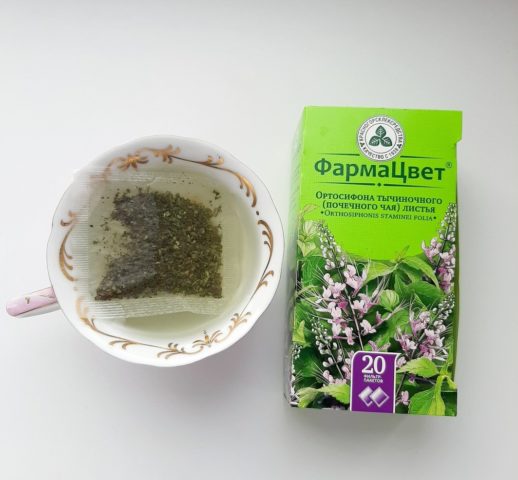
How to take kidney tea
Orthosiphon staminate kidney tea is taken in accordance with the instructions for use. If the treatment regimen is violated, you may encounter side effects. There are 2 formats for the release of kidney tea on sale. Filter bags are much more convenient as they contain a single dosage. In loose form, the product will have to be measured independently. The duration of the intake of renal tea is determined by the nature and neglect of the disease.
How much to drink kidney tea
To get the desired result, you need to drink kidney tea correctly, taking into account all the recommendations. A single dosage of a medicinal drink is 5-100 ml. Reception is carried out 2-3 times a day. The optimal treatment course is 2-3 weeks.
When is it better to drink kidney tea
It is advisable to take staminate orthosiphon half an hour before meals. Tea does not affect the speed of psychomotor reactions, so it is not forbidden to drink it before bedtime. But you need to understand that after 30-40 minutes after taking, there are frequent urges to urinate.
How to drink kidney tea during pregnancy for edema
To stimulate the outflow of fluid during pregnancy, an infusion of orthosiphon is used. At 1 st. boiling water will take 1 tsp. dry grass. It is poured with water and insisted under the lid for 20-30 minutes. Reception is carried out on ½ st. 2-3 times a day. The therapy will help to normalize blood pressure, restore water-salt balance and reduce swelling.
Kidney tea for cystitis
Cystitis is an inflammatory process in the bladder region. It is accompanied by frequent and painful urination. Orthosiphon decoction is used to treat the disease. 1 tsp herbs pour 200 ml of boiling water and put on the stove. The drink is prepared in a water bath for 15 minutes. After removing from heat, it is cooled to 40 ° C. Reception is carried out on ½ st. 2 times a day.
Kidney teas for sand, kidney stones
Kidney tea is also effective for urolithiasis. To eliminate it, use a decoction of a medicinal plant. It is kept in a water bath for 15 minutes, and then insisted under the lid for another 45 minutes. The finished drink is taken in 100 ml 2 times a day. Such therapy helps prevent the formation of stones and eliminate existing ones. If they are too large, stimulation of the outflow of fluid can provoke blockage of the renal pelvis. This threatens with serious complications requiring surgical intervention. Therefore, treatment in this case must be carried out under the supervision of a physician.

Kidney tea for gout
Kidney tea inhibits the process of salt deposition in the joints. Therefore, it is permissible to use it for gout. The broth is drunk at ½ tbsp. twice a day. The duration of treatment is 2 weeks. As a result of taking renal tea, it is possible to reduce pain and normalize joint mobility.
Kidney tea for kidney cysts
The instructions for kidney tea from the leaves of orthosiphon staminate and reviews on it should be studied by those who are faced with cysts in the kidneys. The medicinal drink is taken in 1 tbsp. 2 times a day. Before starting therapy, you should consult your doctor. Sometimes medications are additionally used.
Orthosiphon staminate with increased intracranial pressure
Kidney tea effectively increases blood pressure, thus normalizing well-being and restoring efficiency. For this, it is customary to brew it in a thermos. For 500 ml of boiling water, 2 tbsp. l. dry mix. The drink should be brewed all night. It is taken 150 ml before each meal.
How to drink kidney tea bags
The form of release of kidney tea in the form of filter bags is considered the most convenient. To obtain a healing drink, 1 package is poured with 200 ml of hot water and infused for 15 minutes. For this purpose, you can use a thermos. In this case, there is no need to filter the drink. Reception is carried out 2-3 times a day.
Kidney tea for weight loss
Orthosiphon staminate has an indirect effect on the figure. It normalizes the water-salt balance and removes excess fluid from the body. Due to this, the weight is reduced. But in order to achieve a pronounced effect, you will also need to limit yourself in the use of high-calorie foods. Losing weight with renal tea for more than 3 weeks is not recommended. After a short break, you can continue the diet.
Contraindications
Under certain circumstances, staminate orthosiphon can be not only beneficial, but also harmful. He has a number of significant contraindications. These include age up to 12 years and individual intolerance. During breastfeeding and pregnancy, the possibility of using tea is discussed with the doctor individually. In this case, the benefits of renal tea treatment should outweigh the potential harm.
Side effects of kidney tea
Improper use of renal tea causes unwanted reactions. They are reflected in a person's well-being. To prevent this from happening, you should follow the dosage and the recommended dosage regimen. It is indicated on the packaging of the kidney tea. In some cases, it is corrected on an individual basis.
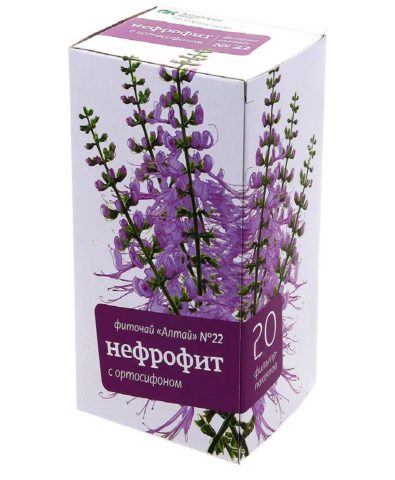
Elderly people and those who have severe chronic diseases should be especially careful during treatment with orthosiphon. When used correctly, it will not have a toxic effect on the body. Possible side effects of kidney tea include:
- allergic reaction;
- lower back pain;
- discomfort in the stomach;
- nausea.
In case of an allergic reaction to renal tea, a skin rash appears in most cases. Sometimes there is a runny nose and watery eyes. With severe allergies, breathing difficulties may occur. This condition is life-threatening, as it may be accompanied by Quincke's edema. To prevent this from happening, you should take an antihistamine.
Collection and procurement
For harvesting, orthosiphon can be grown independently in the garden. But it should be remembered that he needs a lot of light and heat. At temperatures below 5 ° C, the plant dies. For good growth, he should provide abundant watering and fertilization of the soil.
It is customary to collect the leaf part of the orthosiphon 5-6 times per summer. It is plucked from the top of the plant.You can also harvest young shoots with two pairs of inflorescences. The collected raw materials are dried in the open air, providing protection from direct sunlight. You can use a canopy for this. Drying time is 1 day. In this case, the air temperature should be in the range from 30 to 35 ° C. Leaves and stems should break easily when pressed by the time the drying is complete.
In an electronic dryer, the raw material procurement process is faster. It is used in cases where there is no suitable weather or place for drying. In this case, it is extremely important not to overdry the plant, as it can lose most of its beneficial properties.
Dried kidney tea is stored in a tightly closed container at room temperature. It is advisable to take care of protection from moisture and direct sunlight. Otherwise, the raw material will lose its useful properties or become covered with mold.
Conclusion
The medicinal properties of staminate orthosiphon and contraindications are required to be studied before phytotherapy. In case of a complicated course of the disease, it is advisable to consult a doctor. In this case, drug therapy may be required.

